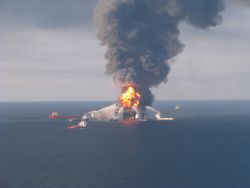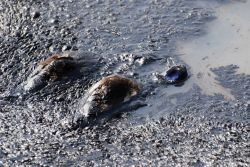"Windmills not Oil Spills" — I saw this bumper sticker during the BP disaster. A Google search unearthed some even more provocative bumper stickers: "Plug the Damn Hole!" and "Way to go Gashole."
 I'm hoping the vehicle owners that brandish these stickers will also realize the irony of an anti-oil sticker on a gasoline-fuelled bumper, regardless of its tagline. Surely they understand the connection between the Gulf disaster and their own steering wheel?
I'm hoping the vehicle owners that brandish these stickers will also realize the irony of an anti-oil sticker on a gasoline-fuelled bumper, regardless of its tagline. Surely they understand the connection between the Gulf disaster and their own steering wheel?
Here in Ontario, very little of our gasoline comes from the Gulf or the U.S. for that matter — only about 4 per cent in total, whether on land or offshore. On the other hand, three-quarters of our gasoline comes from Alberta, about 43 per cent of that from the oilsands, which has its own host of ecological consequences.
Oilsands generate their own ongoing waste - liquid tailings, a toxic byproduct of oilsands production, which regulators in Alberta perennially waive clean up requirements for. And it's down to these tailings that more than 1600 ducks died, not so dissimilar to the pelicans that died in the Gulf disaster. The ducks died two years ago in one of Syncrude's toxic liquid tailings lakes and 164 other animals, including 27 bears, have died at similar oilsands operations between 2000 and 2008. The pace of oilsands production is occurring prior to the development of adequate rules to protect the environment. 
But the link between these ecological impacts and our gas tanks goes beyond the source of our fuel — it's about how our collective demand for oil is driving up the impacts and risks of oil production.
Escalating global demand for oil is hastening oil production, weakening regulations and increasing accidents. The BP disaster, the Enbridge pipeline spill in the Kalamazoo River and ongoing environmental impacts from oil sands development are all symptoms of the same problem. Oil is a finite resource that is getting more difficult and expensive to extract, and the environmental risks of producing oil are on the rise.
Now that Deepwater Horizon finally seems to be capped and the Enbridge spill contained, politicians in Canada and the U.S. are asking how we can prevent future disasters from happening.
Answering that question means we must consider how we can reduce the amount of oil we consume.
Ontario is a good place to start. Ontario consumes a third of all the refined petroleum in Canada, and more than 80 per cent of that oil is used by the transportation sector. But Ontarians can also be leaders in reducing the devastating environmental and social impacts of oilsands production and offshore drilling. 
Pembina's new report, Bridging the Gulf highlights the connection between the choices made by commuters in Ontario and the negative impacts of oil extraction in North America, in light of the recent events such as the Gulf disaster. The report focuses exclusively on personal transportation — how Ontarians get around every day — and presents five key actions to reduce oil demand in Ontario by 25 per cent in 20 years, mainly by expanding, funding or complimenting existing policies and programs.
Ontario is in an excellent position, possibly the best in Canada, to start making significant reductions in transportation fuel use. We have everything in place: from a comprehensive transit plan that just requires funding, to an electricity grid that is becoming greener and is ready to accommodate electric vehicles.
It's true that for the past century, oil has driven unprecedented economic prosperity and shaped our current way of life. And reliance on oil will continue for some time. What is needed today are actions and commitments to begin reducing oil demand and to spark a transition to alternatives that are not only safer and cleaner, but also stimulate jobs and economic growth here at home.
Ontario spends $13.2 billion every year to import oil for the transportation sector. Oil imports prevented or saved keeps money in the province that can be invested in transit, vehicle technology and transportation jobs - such as the electric buses made in Quebec for the roads of Quebec.
Think of the bumper sticker potential in Ontario if we introduced these policies: "My other car is electric" or "Tolls pay for transit and cleaner air" or "God Bless Metrolinx."
Moreover, if Ontario's proposed Green Licensing Program goes ahead and is applied to both electric vehicles and very fuel efficient cars - the drivers won't need a bumper sticker; the licence plate would boast the merits of the green vehicle as it cruised down a designated lane along with carpoolers, leaving the gas guzzlers in the dust.
Cherise Burda was Ontario director at the Pembina Institute until 2015.



